TERMINAL
LEARNING OBJECTIVES
1.
Given individual combat equipment and cleaning materials, maintain
combat equipment, per the references. (FMST-FP-1108)
2.
Given individual combat equipment, prepare individual combat
equipment for tactical operations, to support mission requirements.
(FMST-FP-1215)
3.
Given the required clothing, wear the USMC utility uniform, per
the references. (FMST-HSS-1105)
ENABLING LEARNING OBJECTIVES
1.
Without the aid of references, given the prescribed combat equipment,
maintain all items, per the student handout. (FMST- FP1108a)
2.
Without the aid of references, given combat equipment, assemble gear,
per the student handout. (FMST-FP-1215a)
3.
Without the aid of references, given assembled gear, wear combat
equipment to demonstrate proper fit, per the student handout
(FMST-FP-1215b)
4.
Without the aid of references, given lists of uniform items and ownership
marking locations, select the proper marking location for each uniform item,
per the student handout. (FMST-HSS-1105a)
5.
Without the aid of references, given a list, select the proper wear
for each item, per the student handout. (FMST-HSS-1105b)
1.
MARINE CORPS COMBAT UTILITY UNIFORM (MCCUU)
The Marine Corps prides itself with exceptional adherence to uniform standards.
Marines are expected to always present a sharp, well maintained, squared away
image. All Navy personnel assigned to Marine units are expected to present the
same image. Wearing of the utility uniform requires complete compliance with
Marine Corps uniform regulations.
Items issued - standard issue to Navy personnel serving with
Marine Corps units.
|
Infantry combat boots |
1 pair |
|
Hot weather
boots |
1 pair |
|
Utility cover (without Marine
emblem) |
1 Woodland 1 Desert
|
|
Booney/field cover |
1 Woodland 1 Desert |
|
Combat utility blouse |
2 Woodland 2 Desert |
|
Combat utility trousers |
2 Woodland 2 Desert |
|
Cushion sole socks |
6 pairs |
|
HM/RP collar insignia |
2 |
|
Name tapes |
4 sets each |
|
Sweat shirt |
1 |
|
Sweat pants |
1 |
|
Web belt |
1 |
|
Belt buckle |
1 |
|
Glowbelt |
1 |
|
Shorts (green) |
1 |
|
Sweater |
1 |
|
Green undershirt |
6 (3 cotton and 3 synthetic) |
2.
WEAR
Proper wear of the MCCUU
Design - the utility uniform is designed for field wear and should
be loose-fitting and comfortable. The size selected should fit loosely to allow
for some shrinkage without rendering the garment unusable.
Blouse - the utility blouse will not be tucked into the trousers. At the
option of local commanders, sleeves may be rolled up or down depending on time
of year or weather. The woodland uniform will be worn in the winter with
sleeves unrolled. The desert uniform will be worn in the summer months with
sleeves rolled up. When sleeves are worn “up” they will have a three inch fold
terminating about two inches above the elbow. The utility blouse should always
be kept buttoned. Large or heavy objects should not be carried in the pockets.
Trousers - when combat boots are worn, the trousers will be
bloused in a neat and uniform manner. In garrison, the cargo pockets on the
trousers will not be used.
Cover - all personnel, E-4 and above, will wear a subdued (black)
cover device. Navy personnel are to use the cover without the embroderied EGA.
If unable to obtain a cover without the EGA, nothing will be placed over the EGA.
Belt - all personnel will wear the tan khaki web belt or a Marine Corps
Martial Arts Belt. The Marine Corps Martial Arts Program (MCMAP) has a
designated belt ranking system. Only those individuals who attend the MCMAP
course and qualify are authorized to wear the appropriate belt.
Sweater - Navy officer and enlisted personnel may wear the green (Wooley
Pully) or black service sweater with the combat utility uniform. The sweater
will be worn underneath the utility blouse with sleeves down.
Raingear - Navy personnel will wear the Navy issued black raincoat or
organizational rainwear as issued by the Marine Corps with the combat utility
uniform.
Insignia
The rating insignia
is worn on the left collar, bisecting the angle of the point
of the collar, and equally spaced 1/2” from either side of the collar (see
figure 1).

Figure 1. HM Rating Insignia
The rank insignia is worn on the right collar, bisecting the angle
of the point of the collar, and equally spaced ½ inch from either side of the
collar (see figures 2, 3, and 4).

Figure 2. E-2 and E-3 Rank Insignia
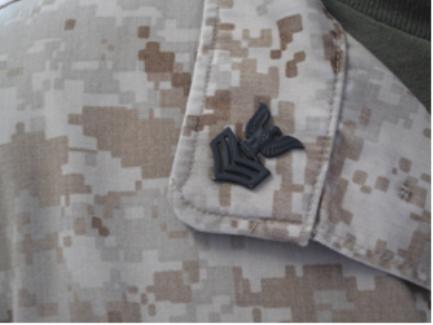
Figure 3. E-4 through E-6 Rank
Insignia
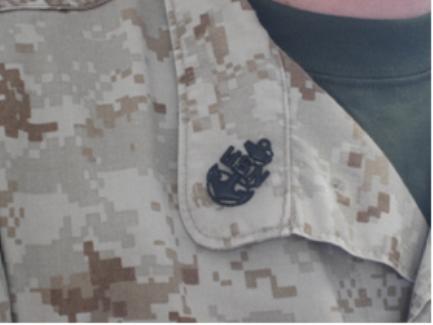
Figure 4. E-7 through E-9 Rank Insignia
The bottom edge of the warfare device will be centered over the
left pocket on a horizontal line (parallel to the ground), even with the highest
point of the service tape. If a second device is authorized, it will be worn
1/8 inch above the first device (see figure 5).

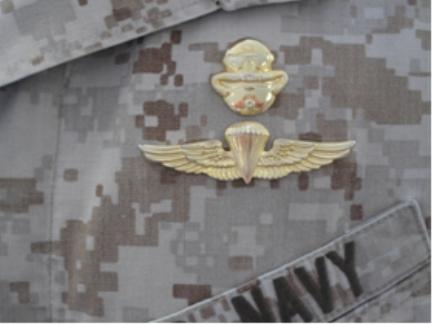
Figure 5. Warfare Device
Centered
3. UNAUTHORIZED WEAR
OF THE MCCUU
The wearing of the MCCUU and
its policies are much like the Navy’s utility uniform (Dungarees). Members are
prohibited from wearing the utility uniform off base with the
following exceptions:
- To and from work while in a
vehicle.
- During medical emergencies.
- Circumstances that are beyond
your control (vehicle breakdown).
- While visiting drive-throughs
that do not require you to exit the vehicle.
4.
CARE OF THE MCCUU
The MCCUU is designed for easy
care. These uniforms are designed as a wash-and-wear uniform. If needed, a
hand iron on a low heat setting may be used. The use of starch, sizing and any
process that involves dry cleaning or a steam press will adversely affect the
treatments and durability of the uniform and is NOT recommended.
5.
MARKING
Enlisted Sailors will plainly and indelibly mark every article of uniform
clothing with the owner’s name (except for organizational clothing).
Size - letters will be of a size appropriate to the article of
clothing and the space available for marking and will consist of block leters
not more than ½ inch in size. Marking machines, stencils, name tapes, or stamps
may be used.
Color - names are marked in black, on light colored material and
utilities, and in white on dark material. Marks will be placed so that they do
not show when the clothing is worn.
Location - the
precise location for marking the following gear is as follows:
Duffel bag - on
the outside of the bag on the bottom
Web belt - on one side
only, as near to the buckle end as possible
Cover - inside, on the
sweatband
Coats and overcoats -
inside, on the neckband
Drawers - outside
immediately below the waistband, near the front
Gloves - inside, at the
wrist
Shoes and boots -
inside, near the top
Socks - outside, on top
of the foot
Utility blouse -
name-tape sewn above right breast pocket, service tape sewn above left breast
pocket; mark inside of blouse as well.
Trousers - name-tape
sewn above right rear pocket; mark inside of trousers as well.
Undershirt - inside
back, near the neck-band
6.
GROOMING STANDARDS/PERSONAL APPEARANCE
Members will present the best
possible image at all times and continue to set the example while in and out of
uniform. Members are prohibited from:
-
Mutilation of the body or any body parts in any manner.
-
Attaching, affixing or displaying objects, articles, jewelry, or ornamentation
to, through or under skin, tongue, or any other body part. Female members may
not wear earrings in combat utility uniform.
-
Tattoos or brands on the neck and head. On other areas of the body, tattoos or
brands that are prejudicial to good order, discipline and morale or are of a
nature to bring discredit upon the Marine Corps are also prohibited.
- Having
eccentric or faddish styles of hair, jewelry, or eyeglasses. The good judgment
of all members at all levels is key to enforcement of Marine Corps standards
with this issue.
-
Chewing gum, chewing tobacco, cigarettes, or the consumption of food while in
formation or walking in uniform.
-
Articles that are not authorized for wear as a part of a regulation uniform will
not be worn with the uniform such as: pens, watch chains, backpacks/bags (over
the shoulder), CD/MP3 players or other similar items.
- For
females, barrettes, combs, rubber bands, etc. are authorized, if concealed by
the hair.
- Cellular phones (personally owned and organizationally issued) and other
electronic equipment will not be worn exposed on Marine Corps uniforms.
-
Sunglasses will be conservative in nature and will not be worn indoors or in
formations unless authorized by a medical representative.
- The
wearing of clothing articles not specifically designed to be normally worn as
headgear (e.g. bandanas, doo rags) is strictly prohibited in civilian attire and
while in uniform.
- No
part of a prescribed uniform, except those items not exclusively military in
character, will be worn with civilian clothing.
7.
INDIVIDUAL COMBAT EQUIPMENT
|
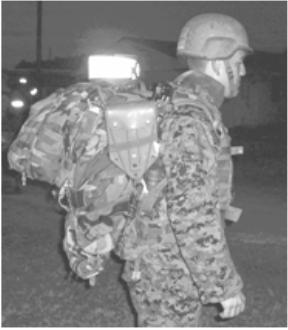
Figure 6. MOLLE Sideview
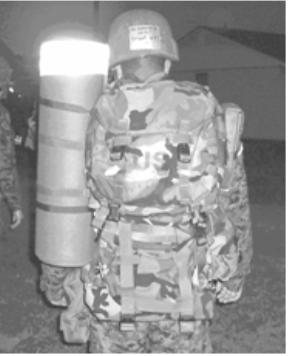
Figure 7. MOLLE Backview
|
Modular Lightweight Load-Carrying Equipment (MOLLE) - MOLLE is a
modular Load-Bearing system designed to enhance the survivability and lethality
of the modern Marine. MOLLE is a replacement for the ALICE system and
components of the Integrated Individual Fighting system including the Enhanced
Tactical Load-Bearing Vest (see figures 6 and 7). The MOLLE consists of the
following:
Fighting Load Vest (to
include belt) - the vest is designed to reduce heat build up
on the back with minimum area of coverage with the H-Harness design. The wide
shoulder straps of the vest help distribute the load without the need for
excessive padding that can hinder mobility and sighting a weapon.
Corpsman Configuration -
will receive four zippered medical pockets, the vest and two
double 30 round magazine
pockets. In addition to the configuration worn, the individual will also
receive two single 30 round magazine pockets and two fragmentation grenade
pockets.
Main Rucksack - the
rucksack and shoulder straps come pre-assembled to the frame. The ruck sack may
be worn with or without the frame.
Sleep System Carrier -
designed to carry the sleeping system.
Patrol Pack - utilized
to sustain an individual for 24-48 hour period. It is also known as the day
pack.
Frame - utilized
to provide rigidity to the main ruck sack and sleep system carrier.
Sustainment Pockets -
attached to outside of the pack as needed for additional load capability.
Butt Pack - holds extra
gear such as socks, one MRE, foot powder, and note taking gear, and may be worn
separately.
Hydration Bladder - used
to drink on the move.
Repair Kit - utilized to
repair the equipment as needed.
Additional Pockets -
pockets can be added and removed as mission requires.
8.
Additional Equipment
Small Arms Ammunition Cases
M16A2 Rifle Case -
holds two magazines of 30 rounds.
M9 Service Pistol Case
- holds one magazine of 15 rounds .
Canteen Cover - the
canteen covers are used to carry the plastic water canteens and metal cup. The
covers have two small pockets attached for carrying water purification tablets.
Flak Jacket - it is
designed to be worn as a jacket by an individual to stop shrapnel, it is not
bullet proof.
Helmet With Cover - it
is designed to be worn on the head by the individual to stop shrapnel; again, it
is not bullet proof.
ISO Mat - a foam padding used to support the sleeping system.
9.
Cleaning and Maintenance
- Scrape
dirt and dust from the item using a brush that will not cut the fabric.
- Hose or
wash the item in a pail of water. Rinse thoroughly with clean water.
- Do not use
chlorine bleach, yellow soap, cleaning fluids, or solvents that will discolor or
deteriorate the item.
- Dry item in
the shade or indoors. Do not dry in direct sunlight, direct heat, or open
flame.
- Do not
launder or dry item in home or commercial washers and dryers. Do not attempt to
dye or repair. Turn in for repair or replacement.
- Remember,
extremely dirty or damaged equipment can eventually fail to perform its intended
function. Clean it or turn it in for repair or replacement.
REFERENCES
Marine Corps Uniform Regulations, MCO P1020.34G: Ch 2, 3,
4, 8, 10
ALMAR 035/07
REV: July 2008
Uniform Review
1. Rating devices(HM/RP insignia) is
worn on which collar?
2. What type of device is worn by
all E-4 and above on their cover?
3. Warfare devices are worn on which
side of the blouse?
4. List two places where the wearing
of sunglasses is specifically prohibited.







